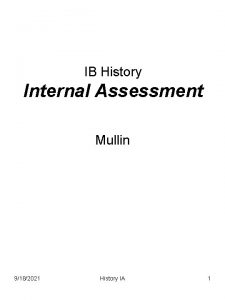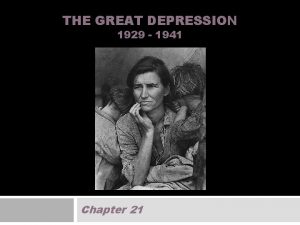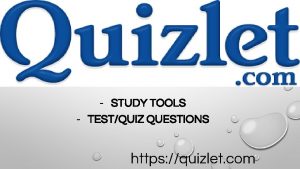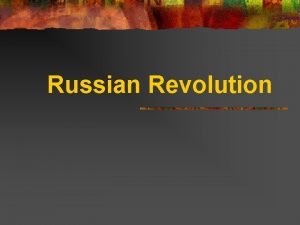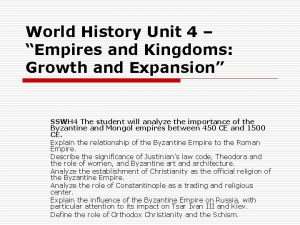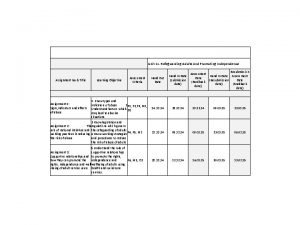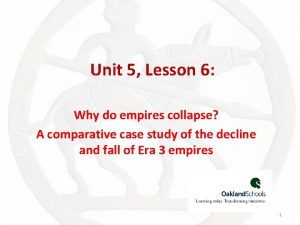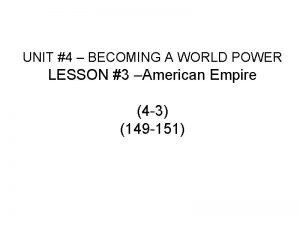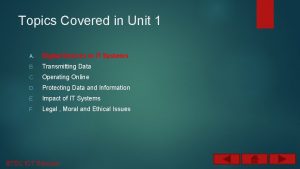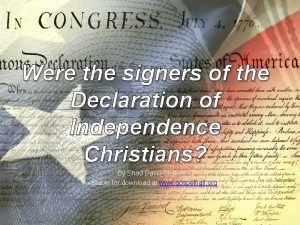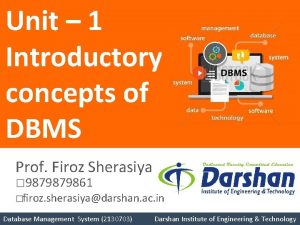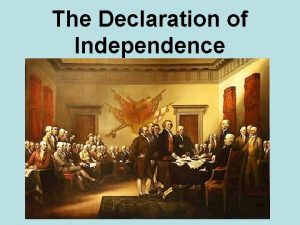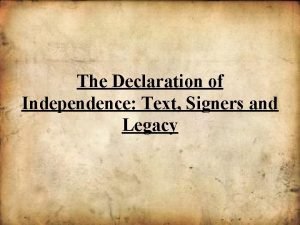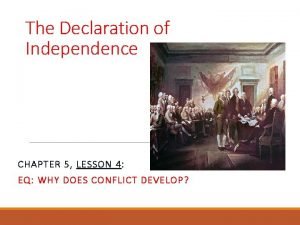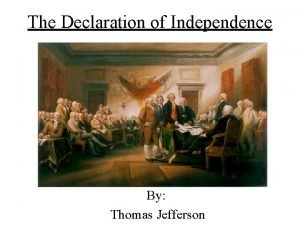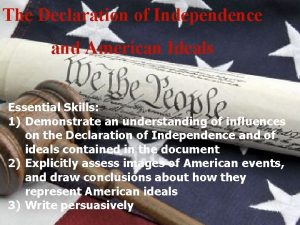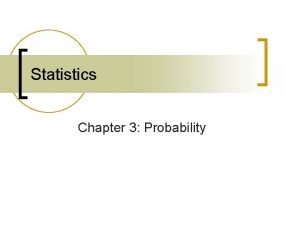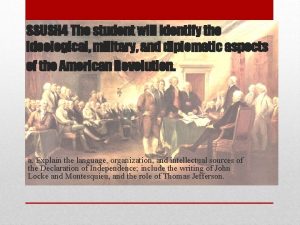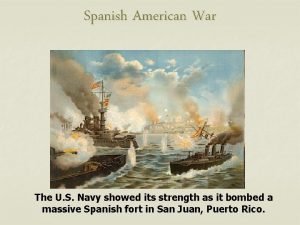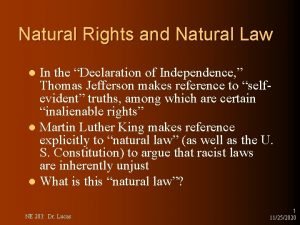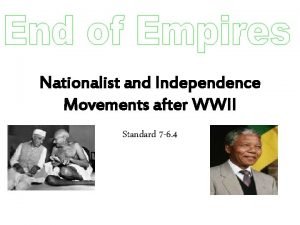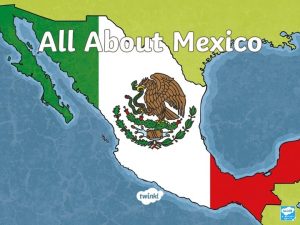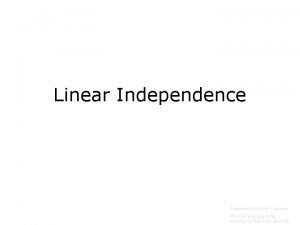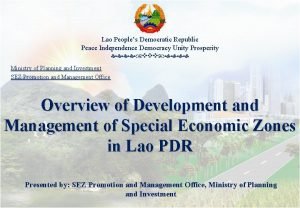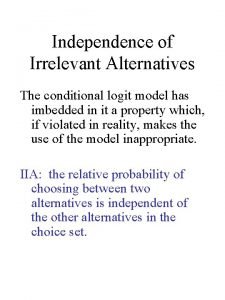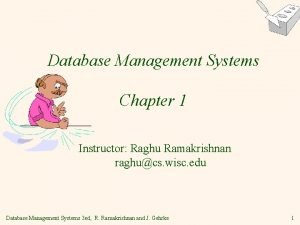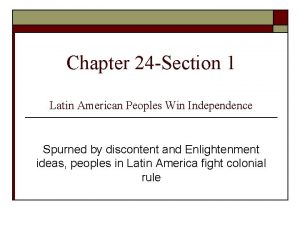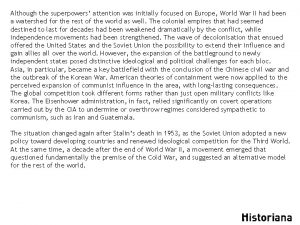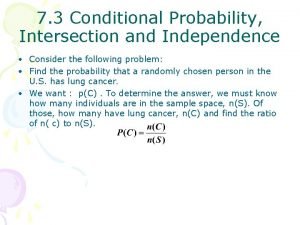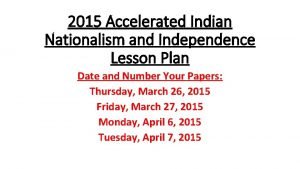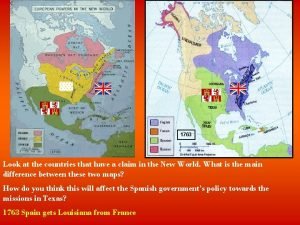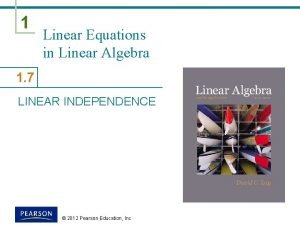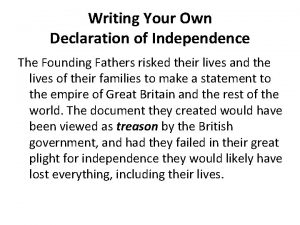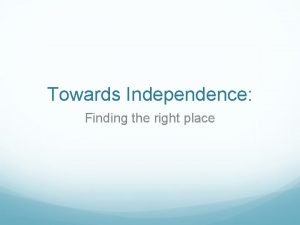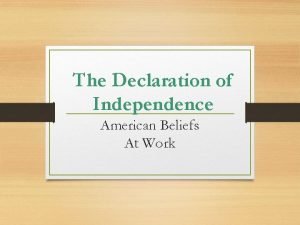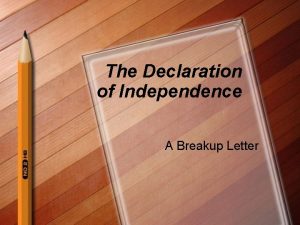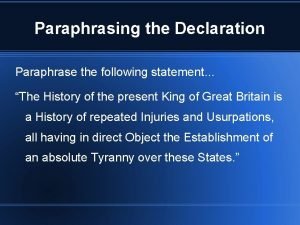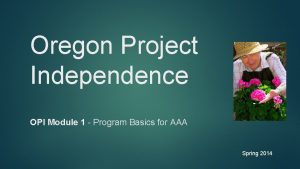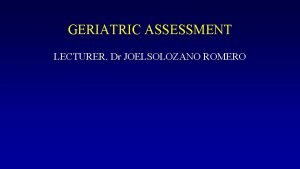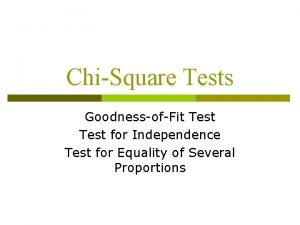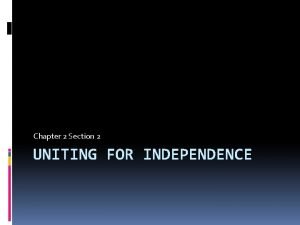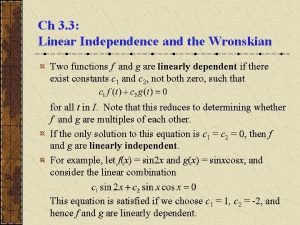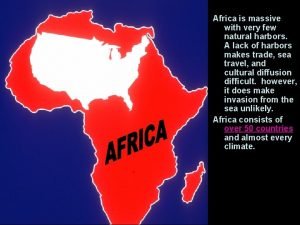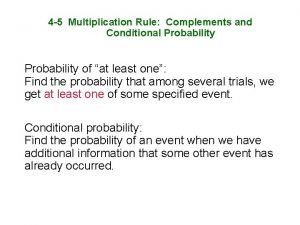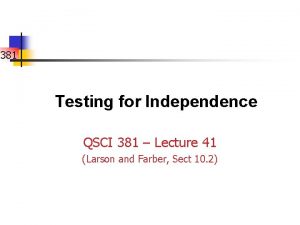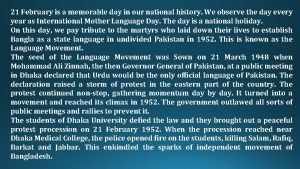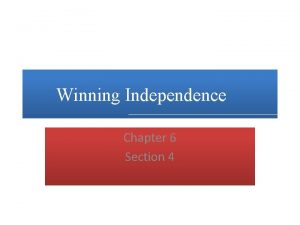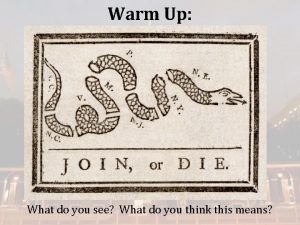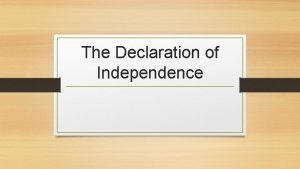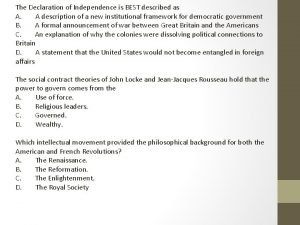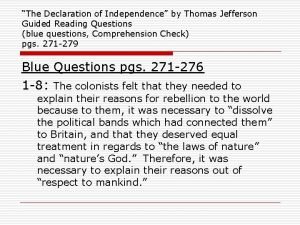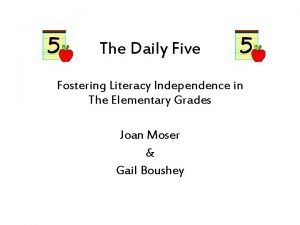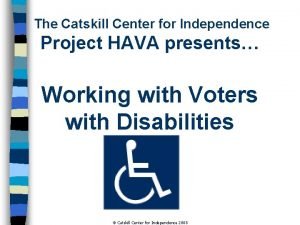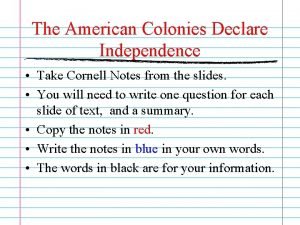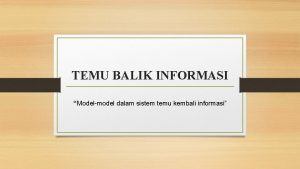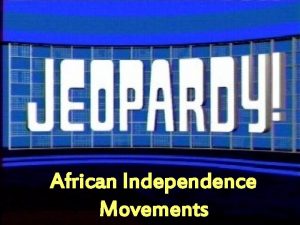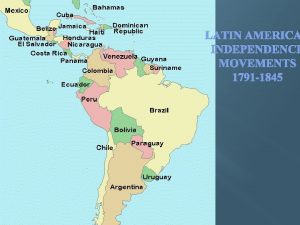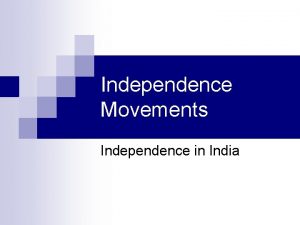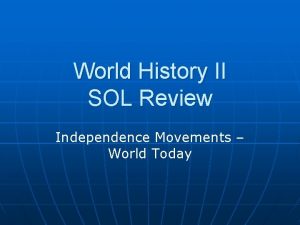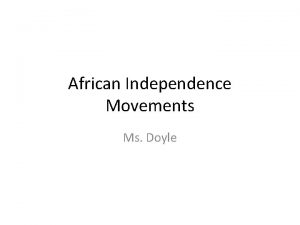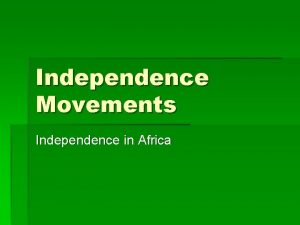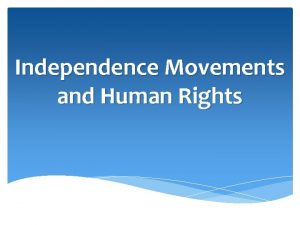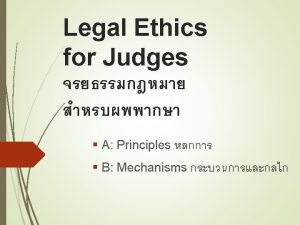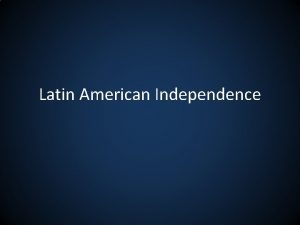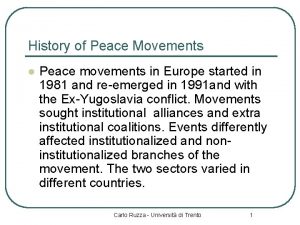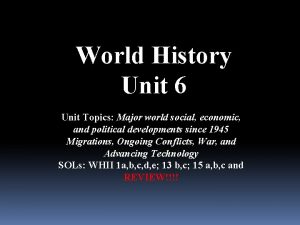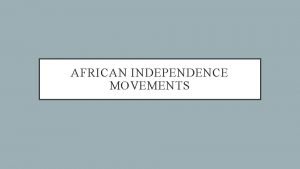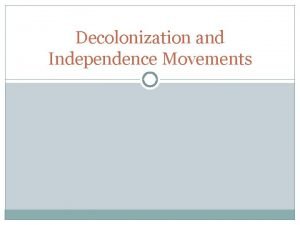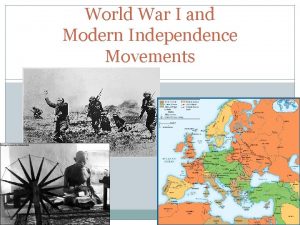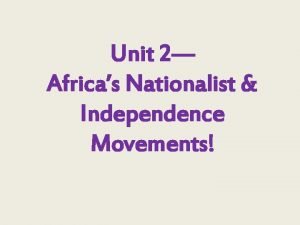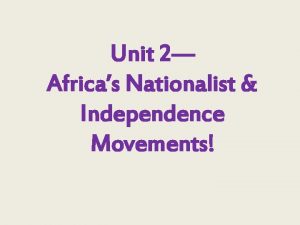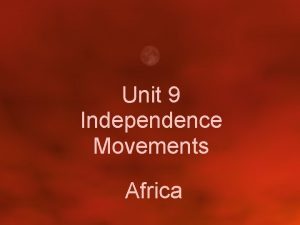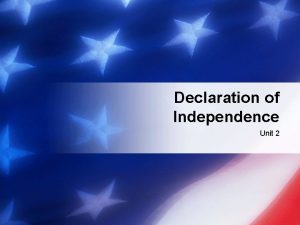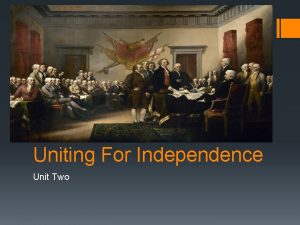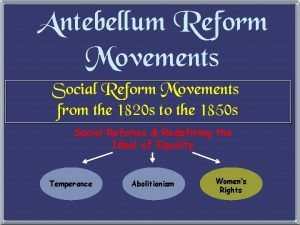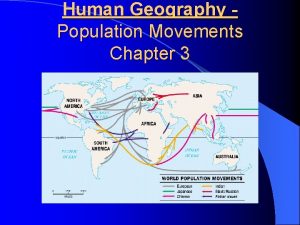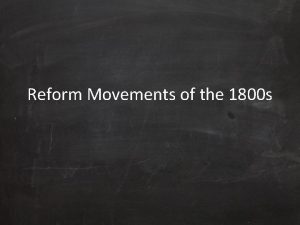World History Unit 6 Unit Topics Independence Movements








































































- Slides: 72

World History Unit 6 Unit Topics: Independence Movements; regional social, economic, and political developments since 1945”, Wars and Advancing Technology SOLs: WHII 1 a, b, c, d, e; 13 b, c; 15 a, b, c and embedded SOL REVIEW!!!!

WH II 14: REVIEW INDIA!!! The student will demonstrate knowledge of political, economic, social, and cultural aspects of independence movements and development efforts by a) describing the struggles for self-rule, including Gandhi’s leadership in India and the development of India’s democracy b) describing Africa’s achievement of independence, including Jomo Kenyatta’s leadership of Kenya and Nelson Mandela’s c) describing the end of the mandate system and the creation of states in the Middle East, including the roles of Golda Meir and Gamal Abdul Nasser.

India: Independence What do you know about each of the following: Hinduism: Islam: Gandhi: Nehru: Jinnah: Indira Gandhi:

Independence for India British policies and the demand for self rule led to the rise of Indian Independence movements, which resulted in the creation of new states in the Indian sub continent. What were the British policies? Who made demands for independence? What methods did they use?

GEOGRAPHY of “India” on a map Find on the Indian sub-continent: Area called “British India” The Republic of India, a democratic nation that developed after independence Pakistan (formerly WEST Pakistan) Bangladesh (formerly EAST Pakistan) Sri Lanka (formerly CEYLON)

Independence in Africa: describe Africa’s achievement of independence, including Jomo Kenyatta’s leadership of Kenya and Nelson Mandela’s Jomo Kenyatta Nelson Mandela Other independence leaders: (see chart)

African Independence: POST WWII Independence due to: “Right to self-determination” is part of the UN Charter Increasing pride in African cultures and heritage Resentment toward imperial rule and economic exploitation Loss of colonies by Great Britain, France, Belgium and Portugal Influence of the post-WWII superpower rivalry during the COLD WAR

Independence in Africa West vs. East WEST Africa = PEACFUL EAST Africa = VIOLENT


African Independence Revolutions were both peaceful AND violent WEST Africa = mostly peaceful (Ghana) Algeria : War for Independence from France= (VIOLENT) EAST Africa = many VIOLENT revolutions Kenya= VIOLENT (Jomo Kenyatta, Mau-Mau, etc. ) South Africa = VIOLENT also APARTHEID (racial segregation was a big problem and led to international outcry to end it) Nelson Mandela’s leadership was crucial

African Independence: Kwame Nkrumah Ghana (Gold Coast): British colony

African Independence: JOMO KENYATTA Kenya (British colony)

African Independence: Mau-Mau Kenya (British colony) VIOLENT

African Independence: Idi Amin Uganda—British colony VIOLENT!

African Independence: Nelson Mandela South Africa (Dutch, then British colony) VIOLENT British fought Dutch farmers known as BOERS British fought ZULU tribe, led by Shaka ZULU

African Independence: F. W. de Klerk*

Archbishop Desmond Tutu Awarded the Nobel Peace Prize in 1984, this Anglican Archbishop supported economic sanctions against his own country and other nonviolent means to challenge the system of racial segregation in South Africa. (APARTHEID)

African Independence: Mobutu Sese Seko Democratic Republic of the Congo (formerly known as ZAIRE…and formerly known as the Belgian Congo!) Renamed Democratic Republic of the Congo after Sese Seko was overthrown

African Independence: Robert Mugabe Zimbabwe (formerly Rhodesia) Named after Cecil Rhodes (a British imperialist)


Robert Mugabe This Rhodesian nationalist leader fought against white minority rule and helped bring about independence in 1980. The country was renamed Zimbabwe after an ancient African kingdom and this man was elected president. He insisted on one party rule and tolerated little opposition.


African Independence: Ian Smith* Rhodesia (before it became “Zimbabwe”) -British colony

African Independence: Julius Nyerere Tanzania—British colony

See page 704 in the book!

Review history of: Monotheism Judaism Christianity Islam

Middle East: describe the end of the mandate system and the creation of states in the Middle East, including the roles of Golda Meir and Gamal Abdel Nasser. Review: Colonialism, Berlin Conference, religion, WW I and WWII, Holocaust, establishment of Israel, and related events

Middle East: Peace and Conflict Nationalism and the mandate system after WWI (REVIEW!) UN decision to END the mandate system after WWII Religious conflicts cause TENSION and violence Economic development and the tension between modernization and westernization Arab-Israeli Dispute (ongoing) Egypt and the Suez Canal (Suez Crisis)

Middle East: Peace and Conflict Mandates (after WWI) to know and find on a map: FRENCH = Syria and Lebanon BRITISH = Jordan (called Transjordan) and Palestine (part became independent as the State of Israel in 1948) Can you discuss part of the HISTORY and culture of the mandates before, during and after the mandate era?

Middle East: Golda Meir Prime minister of Israel* led Israel (after initial setbacks) to victory in the Yom Kippur War* Strong support of the United States

Israel’s position is vulnerable in the Middle East

Middle East: Gamal Abdel NASSER President of Egypt Nationalized the Suez Canal (took it from British control) Established a relationship with the Soviet Union during the Cold War Built the Aswan High Dam

Gamal Abdel NASSER founder of the so-called “Non-Aligned Movement” ( India and Yugoslavia) developed close relations with the Soviet Union. USSR its satellites became chief source of military equipment and financial aid, beginning with a massive arms deal with Czechoslovakia in 1955. May of 1967, Nasser expelled UN peacekeepers from the Sinai peninsula and announced a blockade of the Straits of Tiran to Israel-bound shipping. (Openly declares he wants to destroy Israel)

Key “wars” to remember about Israel and its neighbors 1948: State of Israel is created Immediately invaded by : Egypt, Jordan, Lebanon, and Syria Suez Crisis (Nasser in Egypt) and later the Six Day War 1967 1973 Yom Kippur War (vs. Egypt and Syria)

Six Day War the third major Arab-Israeli conflict — was in a sense a continuation of the first two wars. Broadly speaking, the causes of the fighting in 1967 overlapped with the causes of fighting in 1948 (Arab rejection of Israel) and 1956 (continued rejectionism and an Egyptian blockade of shipping to Israel). Israel, Egypt, Syria and Jordan were the key players

Middle East Conflict as part of the COLD WAR: Geopolitical aspects of Six Day War 1967: As American relations with Egypt soured, the Soviet Union stepped up its influence in the Arab world, working to build (pro. Soviet) Arab unity by focusing Arab attention on their common enemy, Israel USA tries to get Israel to “hold off” and never strike first. USA provides intelligence to assist Israel make every strike count when they have to

Middle East: Yasir Arafat Committed soldier against state of Israel Head of the PLO (independent nationalist organization) By 1988, he “renounces” violence and by 1993 signs Oslo Peace Accords with Rabin…. BUT, a new intifada begins 2000…. …Arafat dies in 2004

Oslo Peace Accords, 1993 TERMS for Palestinians were to include: Self rule in West Bank & Gaza Strip (find those on the map) renunciation of terrorism (STOP being terrorists!) Recognize Israel’s right to exist”

Middle East: Yitzak Rabin Gets a Nobel Peace Prize with Arafat Assassinated by a Jewish student

Middle East: Ayatollah Khomeini Installed after 1979 Islamic Revolution that overthrew Pahlavi Dynasty in Iran US embassy was raided and US hostages held until 1980

SEE PAGE 713 in the book!

Review the following world leaders who made major contributions to events in the second half of the twentieth century Country? Religion? Notable cultural features? Relationship with USA & USSR during Cold War Era? Current Events?

Indira Gandhi: From India Closer relationship between India and the Soviet Union during the Cold War Developed nuclear program

Margaret Thatcher British prime minister Free trade and less government regulation of business Close relationship with United States and U. S. foreign policy Assertion of United Kingdom’s military power

Mikhail Gorbachev & Ronald Reagan Glasnost (“openness”= free speech, press) and perestroika (“restructuring” of the Soviet economy: market, free enterprise with some private business) Last “president” of Soviet Union

Deng Xiaoping Reformed Communist China’s economy to a market economy leading to rapid economic growth Continued communist control of government


Asia in Transition: China after WW II Division of China into two nations at the end of WWII (Taiwan and People’s Republic of China) Communist China participated in Korean Conflict on North Korea’s side Modern leadership of DENG XIAOPENG/REFORMS ECONOMY

China after Mao: DENG XIAOPING Reformed communist economy to market economy leading to RAPID ECONOMIC GROWTH Continued Communist control of the government Tiananmen Square massacre in 1989 Died 1997

Asia in Transition: Southeast Asia and the struggle to establish democratic gov’t Colonial heritage Ethnic and religious conflict

Asia in Transition: Japan and the “ASIAN TIGERS” These areas have created successful industrial economies and are the new “powerhouses” of the global economy Japan South Korea Singapore Hong Kong

Can you identify the nations of Asia and Southeast Asia and discuss the religion and histories of those nations?

IMPORTANT “End of the Semester Items” to wrap it all up: Terrorism & Global Security concerns Global economy Technology and Communications Revolution Energy and “Green” Info The FUTURE

“Analyze the increasing impact of TERRORISM” What is terrorism? What causes terrorism? What are some EXAMPLES of terrorist activities? How has terrorism affected both developed and developing nations?

Terrorism: “the use of violence and threats to intimidate and coerce for political reasons” RELIGIOUS EXTREMISM is a major cause Another cause is the inability to “deal” with inequities in social, cultural or economic systems in a terrorist’s homeland

Terrorism: EXAMPLES Munich Olympics in 1972 (PLO murdered Israeli athletes in the Olympic Village dorms) USA on Sept. 11, 2001 (9 -11) (Muslim extremists encouraged by Osama Bin Laden attacked Twin Towers in NTC and the Pentagon in Washington, DC) Car bombings Suicide Bombers Airline Hijackers

Munich, Germany Sept. 5, 1972: Early group of the Palestinian Liberation Organization (PLO) calling themselves “Black September” attacked Israeli athletes in Olympic Hostages all killed at airport

Osama Bin Laden & his religious extremists on Sept. 11 th, 2001

Government Responses to Terrorism: SURVEILLANCE of “suspects” Restriction of some privacy rights More security at airports and water-ports Increased use of IDENTIFICATION BADGES and PHOTO IDS

WW II 16: The student will demonstrate knowledge of cultural, economic, and social conditions in developed and developing nations of the contemporary world Q: What can you tell me about the HISTORIES of the places in RED? Religions? Colonial ism? Independence Struggles? Terrorist Activities?

A. identifying contemporary political issues, with emphasis on migrations of refugees and others, ethnic/religious conflicts, and the impact of technology, including chemical and biological technologies Q: What are some of the Key Challenges faced by the contemporary world? Q: What new technologies have created both OPPORTUNITIES and challenges?

Challenge: “MIGRATIONS” REFUGEES International conflicts produce waves of refugees fleeing political, ethnic, religious or economic troubles in: Middle East Northern Ireland Balkans Horn of Africa South Asia “GUEST WORKERS” Numbers of “guest workers” flood European cities

New Technologies=Good and/or Bad IMPACT of New Technology? Widespread BUT “UNEQUAL” access to computers Instantaneous communication via internet, cell-phone, IM, social media etc. BIOETHICS of genetic engineering and cloning

b) assessing the impact of economic development and global population growth on the environment and society, including an understanding of the links between economic and political freedom. Q: How does the developing world compare with the developed world in terms of economic, social and population characteristics?

Characteristics: DEVELOPIN G: DEVELOPED: Location on map? Location on Map? Economics weak or “in transition” Strong economics with more “knowledge workers” in service industries Social conditions: literacy rates tend to be LOW here, little access to health care or technologies Population SIZE and growth rates : high Social conditions: HIGH literacy rates, access to health care and technologies Populations are manageable growth is lower

Q: What effect or “IMPACTS” are economic development and rapid population growth having on the ENVIRONMENT?

Negative Effects in “developing countries”: POLLUTION Habitats lost from destruction of environment Global climate change (used to be called “ozone depletion”) Poverty Poor health Illiteracy (people can’t read or write) Famine (people starve) Migrations…. as refugees or “guest workers”

Q: What are the links between economic development and political freedom? FREE market economies (except in China) produce “good things” for the people: Rising standard of living (life is better in general) Expanding and prosperous MIDDLE CLASS Middle Class then DEMANDS more POLITICAL FREEDOMS and INDIVIDUAL RIGHTS (except in China) Look at : TAIWAN (Jiang Jieshi) and SOUTH KOREA (NOT communist)

C. describing economic interdependence including the rise of: • multinational corporations = • international organizations= • trade agreements= Q: How is economic interdependence changing the world?

How is economic interdependence changing the world? Rapid transportation , communication and computer network Rise and influence of MULTINATIONAL CORPORATIONS Changing role of international boundaries Regional integration like European Union Trade Agreements between nations: NAFTA, WTO (World Trade Organization) International Organizations: UN & IMF (International Monetary Fund)

WH II 15: REVIEW!!The student will demonstrate knowledge of Judaism, Christianity, Islam, Buddhism, and Hinduism in the contemporary world by: a) describing their beliefs, sacred writings, traditions and customs b) Locating the geographic distribution of religions in the contemporary world Unofficial “c” is : associating the role of religion in modern political conflicts

Current Status of the World Be able to identify each country (ANY country) on the world map Be able to generalize an intelligent statement about that country regarding: A. Status at 1500 B. Status at 1800 C. Status at 1945 D. Status at 2014 with a current event!
 African independence movements
African independence movements Axial skills
Axial skills Ap world history chapter 25 africa and the atlantic world
Ap world history chapter 25 africa and the atlantic world Dangerous world tour
Dangerous world tour History ia section c
History ia section c Http://www.history.com/topics/great-depression
Http://www.history.com/topics/great-depression Https://*.quizlet.com
Https://*.quizlet.com Http://www.history.com/topics/russian-revolution
Http://www.history.com/topics/russian-revolution (http //www.history.com/topics/byzantine-empire
(http //www.history.com/topics/byzantine-empire Leaving cert history
Leaving cert history Austuriana
Austuriana Unit 11 safeguarding adults and promoting independence
Unit 11 safeguarding adults and promoting independence World history unit 5 lesson 6
World history unit 5 lesson 6 World history unit 4 lesson 3
World history unit 4 lesson 3 What topics will be covered in this unit
What topics will be covered in this unit Also history physical
Also history physical What does the declaration of independence say
What does the declaration of independence say Data independence in dbms
Data independence in dbms Grievances in declaration of independence
Grievances in declaration of independence Declaration of independence sections
Declaration of independence sections Declaration of independence sections
Declaration of independence sections Declaration of independence sections
Declaration of independence sections Declaration of independence all men are created equal
Declaration of independence all men are created equal Ideals in the declaration of independence
Ideals in the declaration of independence Independence probability formula
Independence probability formula Montesquieu declaration of independence
Montesquieu declaration of independence When did cuba gain independence from spain
When did cuba gain independence from spain Pan-african movement stamp
Pan-african movement stamp Oregon project independence
Oregon project independence Natural rights in the declaration of independence
Natural rights in the declaration of independence First country to gain independence from britain
First country to gain independence from britain Mexican independence from spain timeline
Mexican independence from spain timeline Linear independence of vectors
Linear independence of vectors Latin american people win independence
Latin american people win independence Mascot international (lao) sole co. ltd
Mascot international (lao) sole co. ltd Independence of irrelevant alternatives example
Independence of irrelevant alternatives example Thomas hobbes declaration of independence
Thomas hobbes declaration of independence Logical data independence in dbms
Logical data independence in dbms Latin american peoples win independence
Latin american peoples win independence Seato map
Seato map P(a given b) formula
P(a given b) formula Indian independence lesson plan
Indian independence lesson plan Mexican independence from spain timeline
Mexican independence from spain timeline What is linear dependence and independence
What is linear dependence and independence Linear independence
Linear independence Site:slidetodoc.com
Site:slidetodoc.com The seed of independence was sown on 21 february 1952
The seed of independence was sown on 21 february 1952 Towards independence commerce
Towards independence commerce Grievances in the declaration of independence
Grievances in the declaration of independence Declaration of independence breakup letter
Declaration of independence breakup letter Teenage declaration of independence
Teenage declaration of independence Paraphrasing declaration of independence
Paraphrasing declaration of independence Oregon project independence
Oregon project independence Katz index of independence score
Katz index of independence score Declaration of independence document d
Declaration of independence document d Test of independence
Test of independence Lesson 2 uniting for independence
Lesson 2 uniting for independence Wronskian linear independence
Wronskian linear independence First african nation to gain independence
First african nation to gain independence Conditional probability complement
Conditional probability complement Qsci 381
Qsci 381 Seen passage 21 february
Seen passage 21 february Chapter 6 section 4 winning independence
Chapter 6 section 4 winning independence Summary of declaration of independence
Summary of declaration of independence Too late to apologize a declaration lyrics
Too late to apologize a declaration lyrics Declaration of independence
Declaration of independence Declaration of independence jeopardy
Declaration of independence jeopardy The declaration of independence is best described as a what
The declaration of independence is best described as a what Parallelism in the declaration of independence
Parallelism in the declaration of independence 10 steps to independence daily 5
10 steps to independence daily 5 Catskill center for independence
Catskill center for independence Cornell notes on the declaration of independence
Cornell notes on the declaration of independence Binary independence model
Binary independence model




